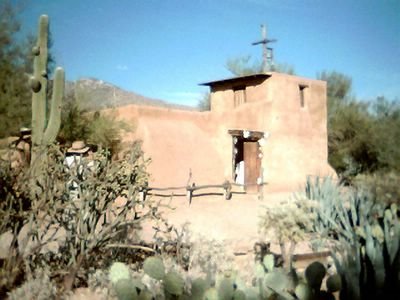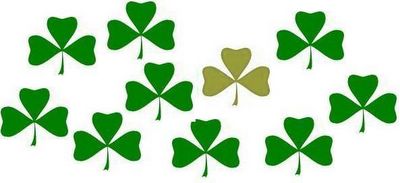Copyright © 2006 by Charles J. Nugent Jr."Ready." "Aim." "Fire!"
At the command "Fire!" five little leprechauns each let go of the taunt rubber bands on their slingshots and silently watched, with breathless anticipation, as five stones sped through the air toward the five aluminum soda cans that had been placed on top of the fence in front of old widow McGuire's cottage.
Seconds later the silence was shattered by the sounds of breaking glass and the thumping of stones against the wall of the cottage.
For the next couple of seconds the leprechauns stood motionless, as if rooted to the ground, as they stared at the five soda cans still standing proudly erect on the fence and shattered window, with its lace curtain blowing in the breeze, behind.
Suddenly, drawn by the noise, the door of old Mr. McGregor's cottage next door opened. Mr. McGregor was a strange, silent old man who was feared by all the young leprechauns. None of them knew why they feared him. But, since he was old with big, bushy eyebrows and a thick mane of grey hair, all the little leprechauns were scared of him. At the sight of Mr. McGregor, the leprechauns scattered.
McGilicudy ran and ran until he finally reached the stream that ran through the little park nearby. Panting and out of breath, he threw himself on the ground and tried to collect his thoughts. However, he suddenly became very troubled and remorseful. First of all, a few weeks ago when the bigger kids he had begun playing with while his friend Sean was away, taught him how to make a sling shot he had gone home and proudly displayed his creation to his father. For some reason his father had told him that it was a dangerous toy and made McGilicudy promise to throw it out. McGilicudy couldn't understand why his father wanted him to get rid of his slingshot. After all, McGilicudy told himself, he was becoming a big boy and ready for new freedom and the responsibility that came with it – hadn't he just finished second grade? He felt that he was well on his way to becoming a man and his father and mother should not keep treating him like a little kid.
But now he was having second thoughts and thinking that maybe his father had been right about the slingshot being dangerous. Then there was that broken window. But, hey, he was only one of five who shot the stones. Maybe his had been one of the ones that had hit the wall of the house. Accidents happen. Besides what could he do about it? Sure, he had $10 that he had been saving in the can under his bed. But Sunday was Father's Day and he planned to use that to buy a gift for his Dad.
"And what is troubling a young tyke like you on this fine morning?" boomed the hearty voice of Father O'Brien, out for his morning stroll in the park.
Shaken from his reverie by Father O'Brien's voice, McGilicudy looked up at the big priest and suddenly felt very small and guilty. In a moment McGilicudy found himself telling Father O'Brien everything and ending with the plea "... and what can I do Father? I want my Dad to treat me like a big boy, but after he learns of this he will be mad and keep treating me like a little kid".
The only way you can get people to treat you like a big boy is to act like one" replied Father O'Brien.
"But how do I do that?" asked McGilicudy. "The window's broken. I can't undo that!"
"You can go to the widow McGuire's house and pay to have the window fixed". Replied Father O'Brien.
“But I only have $10 and that is not enough to buy a new window,” replied McGilicudy. “Besides, I have been saving that money to buy a Father’s Day gift for my Dad.”
“You should have thought of that before you broke the window,” said Fr. O’Brien.
Discouraged, McGilicudy started to walk away, leaving Fr. O’Brien alone to resume his stroll.
After wandering aimlessly for what seemed a long time, McGilicudy headed toward home. As he neared the old widow McGuire’s cottage, McGilicudy crossed the street to put more distance between him and the cottage as he hurried past. But, despite his desire to slip by unnoticed, he couldn’t help taking a quick peek toward the cottage. Seeing poor old widow McGuire struggling to cut up an old box, for cardboard to cover the widow in an attempt to keep the bugs and wind out of her home, only added to McGilicudy’s already overwhelming feelings of guilt.
Poor McGilicudy. He knew that he should admit his guilt and help old widow McGuire, but he also wanted to both get a nice gift for his Father and avoid the punishment that he knew would follow any admission of guilt. Since no one had seen them commit their foul deed there was no need to fear being punished. The big boys had obviously decided to keep quite and escape punishment. McGilicudy did not want to be punished, but he felt so bad about poor old widow McGuire having to go without her window.
By the time he reached home his conscience was bothering him so much that he decided he had to admit his guilt and try to help the old widow. No matter what punishment his Father gave him, it couldn’t be as bad as the guilt he now felt.
Going to his room, he reached under his bed and retrieved the can with the ten dollars he had saved. Leaving the house again he headed for the old widow’s cottage.
After hesitating for a moment in front, McGilicudy opened the gate and entered the front yard. As the gate clanked shut behind him he momentarily froze as Mr. McGregor came around the side of the house with the old widow. McGilicudy wanted to run from the fierce looking old man but his fear was such that his legs would not obey his brain and he remained frozen where he stood.
“And, what be you doing here young un?” demanded Mr. McGregor in his booming voice. With a courage he didn’t know he had, McGilicudy heard his voice reply “I want to pay for the window I broke.”
“I must need new glasses”, muttered Mr. McGregor, “I thought I counted five boys running away from the broken window. How come only the wee man is here to pay?”
Finding his courage growing, McGilicudy replied, “I don’t know where the others are but here is ten dollars to buy a new window.”
“It will take considerably more than ten dollars to repair the damage you and that band of ruffians caused” roared an angry Mr. McGregor.
Hurt and frightened by this big, angry man, McGilicudy began to shake and cry.
Just then, the old widow whacked Mr. McGregor’s leg with her cane and scolded him for being so cruel to a young man who was trying to do the right thing.
Taking pity on McGilicudy and admiring his courage, Mr. McGregor’s mood softened and he said, “if you are willing to help me, I think we can fix this window for ten dollars.”
Giving McGilicudy a pencil and paper, Mr. McGregor took a tape measure from his pocket, and had McGilicudy write down the measurements as he called them out. Then, telling McGilicudy to follow him, he headed for his yard where he took his wheel barrow and started down the street and across the stream to the FitzPatrick and Sons Construction Company’s supply yard. Greeting Mr. FitzPatrick, Mr. McGregor told him the size of glass they needed.
Guiding them to the glass panes Mr. FitzPatrick pointed to the one they needed and said, “that will be twenty dollars.” Putting his big arm around FitzPatrick’s shoulders, Mr. McGregor guided Mr. FitzPatrick away from McGilicudy and, in a hushed and conspiratorial voice, said, “as a dear old friend, why don’t you sell the glass to us for the ten dollars in the can plus the five dollar bill I am slipping into the can?”
Turning back toward McGilicudy, Mr. FitzPatrick said, “for this old piece of glass I think the can with its money will be sufficient.
Thanking Mr. FitzPatrick, McGilicudy helped Mr. McGregor put the glass pane into the wheelbarrow and they returned to the widow’s cottage. For the next two hours McGilicudy helped Mr. McGregor clean up the broken glass and insert the new glass into the old widow’s window. When they finished the window looked like new and McGilicudy’s chest filled with pride at his new found repair skills.
But McGilicudy’s pride and self-satisfaction disappeared the next morning, Father’s Day, when he faced the problem of how to explain his lack of a Father’s Day gift. All through church McGilicudy dreaded having to go home and explain the broken window to his father.
As the family walked home from church, McGilicudy’s mind was filled with fear as he worried about having to face his father with the truth. He was so wrapped up in his worry that he didn’t realize it when his family stopped in front of the old widow’s home. Snapping out of his thoughts of his problems, McGilicudy saw Mr. McGregor, dressed up with a tie and his hair combed and the old widow dressed with a new shawl, inviting his family in for tea and cake.
“Mr. McGilicudy, let me show you the fine new window that that young man of yours helped me replace yesterday,” said Mr. McGregor. “Unlike those other ruffians he was with, your little Mr. McGilicudy here, stepped forward and not only apologized and paid for the damages, but he also gave up his Saturday afternoon to help me replace the window that the five of them broke. And is it not a fine job he did?”
At this, McGilicudy turned to his Father and said, “I’m sorry Dad. I just wanted to play with the big boys. I will give you my slingshot and promise not to make another one again.”
Scooping his son up in his arms, McGilicudy’s Dad was conflicted. On the one hand he was proud of the way his son had taken responsibility and tried to repair the damage he and the others had done. But, on the other hand, he was somewhat angry at the fact that McGilicudy had broken his promise and had continued to use the slingshot.
Sensing McGilicudy’s Dad’s dilemma, Mr. McGregor commented, to no one in particular, “you know, shooting a slingshot can be a lot of fun. I have many fond memories of summer afternoons down in the old meadow with my Pa shooting at targets. You just have to remember not to shoot around people or animals or houses.”
Holding his son in front of him, Mr. McGilicudy said, “you know, Mr. McGregor is right, a slingshot can be fun. Your Grandpa used to take me to the old meadow and we would spend all afternoon shooting at targets.” Setting McGilicudy down, he continued, “I am very proud of you son. I think you have learned a valuable lesson. Now, if you will give me your word, as one man to another, that you will not use your slingshot unless I am with you, I will let you keep it and not punish you further.”
After having tea and cake at the old widow’s home the family went home where, after changing clothes, McGilicudy’s father dug his old slingshot out of the attic and he and McGilicudy spent a wonderful afternoon shooting targets together in the old meadow.
For ever after, McGilicudy’s Father always swore that the best Father’s Day gift he ever received was the pride he felt the Father’s Day that his son took responsibility for his actions and acted honorably.
Copyright © 2006 by Charles J. Nugent Jr.
All rights reserved. No part of this work may be reproduced, in any media or by any means, without the express written consent of the copyright holder.



















